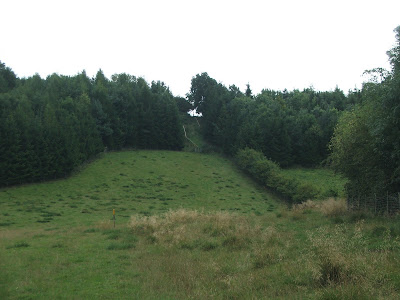Well a lot of water has gone under the bridge since the last time we did any of the Leicester Round. We did parts 1 to 6 in the summer of 2010. Now four summers later we have three kids, two which can walk and a baby that goes into a child carrier. Our walk started in Gumley - a place that had ached in my memory due to the fact that we had got no further than this before. Every time I had surveyed a map of Leicestershire my eye would be drawn to Gumley and my mind play with the unfinished business that it signified. Today we would finally leave Gumley behind.
The start of the walk would take us through the church yard, but unable to find our way out we ended up sticking to the road and skirting around until we picked up the path to Saddington behind the village.
The path descends off Gumley Hill quite steeply. In front of you Saddington is clearly visible beyond Smeeton Hill. In fact Smeeton Hill is where we had our pack lunch - on the conveniently placed bench. It was also a good place to survey the landscape. My eye was initially drawn to the north, where Billesdon Coplow sticks up above the horizon (below).
Further around to the east the square tower of the church at Church Langton could be seen (below) in front of the Langton Caudle. It was from here that I had first sighted Smeeton Hill back in 2010.
Smeeton Hill is also the first place where you can see the four distinctive Gilmorton wind turbines (below). These did not exist back in 2010, but now serve as a handy landmark for working out which way it is to Lutterworth.
Descending down Smeeton Hill presents a few semi nice views of Saddington Reservoir. The linseed in the near-ground field is about a week or two before flowering - so there was the odd blue flower here and there.
After a fairly uneventful approach to Saddington we stopped at the Queen's Head and had a pint. The outdoor seating area was fine but there wasn't any slides or swings or anything for the kids.
The route out of Saddington featured field after field of featureless thistle infested meadow. You couldn't see beyond the field you were in and after a while you stopped caring where you were and only referred to the map when some interesting feature came into view.
Of course there is one rural scene that I like even less than featureless meadow. That is featureless meadow with cows in it. When we got to within sight a farm that the map calls the Elms we entered a field that had a herd of young steers in it. Whilst I was busy trying to fasten the gate back up and my young family half way across the field the herd suddenly stampeded at them. I sprung into action (yes with baby on my back) sprinted to the space between the steers and my family and armed with my trusty quarter staff (yes ok walking stick) stood my ground. Suddenly I was surrounded by shoving, snorting aggressive animals (whilst behind me my kiddies were making for the gate. I gave it my best roar like a lion with the stick above my head - causing the whole herd to scatter in blind panic. Some towards my kids yet again. So I ended up sprinting after them (yes with a baby on my back) and finally headed the last two off and got my family out of there. Perhaps the worst encounter with cows I have ever had. I was left physically shaking. I did not want to see any more cows on this trip. But we did. in fact nearly every field from this point was full of them.
STAMPEDE!
Eventually though the footpath approaches New Inn farm where there are horses. The footpath goes through an electrified paddock where horses are grazing. Still feeling a bit jittery after the episode with the cows we decided to skirt the outside of this on what looked like a horse track. Though sandwiched between a prickly hedge and an electric fence I did wonder what I would do if a 100 horses came bounding around the corner. Luckily for everyone - that did not happen and we ended up crossing the road and entering the village of Shearsby.
Shearsby boasts a nice pub and a large green, with a small playground.


































































